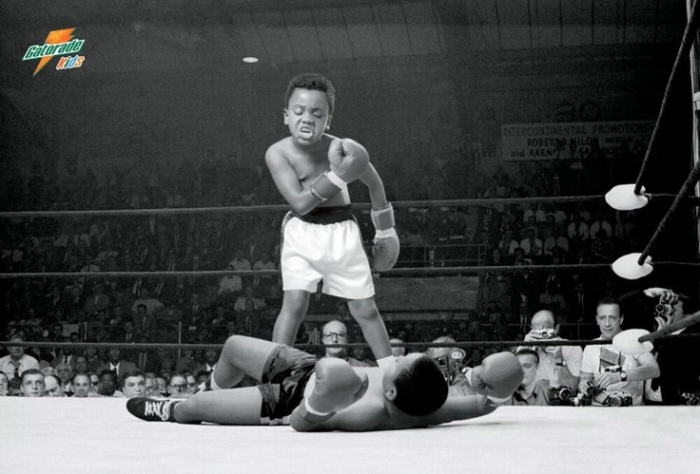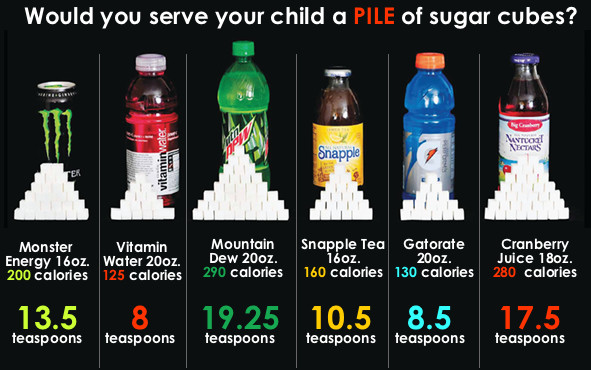The sports drink industry markets their products as a healthy alternative to soda for children and adolescents. Advertisements surrounding sports drinks often center claims on how well the drinks hydrate consumers as well as arguments for physical activity benefits. Advertisements for sports drinks are persuasive and memorable, making the sports drink industry the third-fastest growing beverage category in 2006. In 2010, Gatorade ads were ranked among the top five most-advertised products seen by children and adolescents (Story, 2012).  Despite these exciting claims, research suggests that said benefits for sports drinks are only appropriate for athletes engaged in prolonged vigorous activity; the average American child or adolescent does not engage in enough physical activity to be safe from this warning. This is just one example of how well manufacturers of sugary drinks exploit the health of children and adolescents for the sake of profitability. According to a 2011 analysis by Rudd Center for Food Policy & Obesity, 27% of parents believe that sports drinks are healthy for children, while 40% believe that Gatorade in specific is healthy (Story, 2012). Despite this common belief, the American Academy of Pediatrics recommends that children and adolescents should not consume sports drinks. This blog post will address the health risks and ways to cut down on sugar-sweetened beverages relative to the sugar industry’s exploitation of youth in America.
Despite these exciting claims, research suggests that said benefits for sports drinks are only appropriate for athletes engaged in prolonged vigorous activity; the average American child or adolescent does not engage in enough physical activity to be safe from this warning. This is just one example of how well manufacturers of sugary drinks exploit the health of children and adolescents for the sake of profitability. According to a 2011 analysis by Rudd Center for Food Policy & Obesity, 27% of parents believe that sports drinks are healthy for children, while 40% believe that Gatorade in specific is healthy (Story, 2012). Despite this common belief, the American Academy of Pediatrics recommends that children and adolescents should not consume sports drinks. This blog post will address the health risks and ways to cut down on sugar-sweetened beverages relative to the sugar industry’s exploitation of youth in America.
As parents, it is important to regulate what your child consumes and what detrimental additives come along with it. According to Pomeranz (2012), the consumption of sugar-sweetened beverages is associated with dental caries, increased energy intake, obesity, and is a risk factor for diabetes and heart disease. The concern with children’s health is prominent as childhood obesity has high rates of resulting in obesity later in life, when this health issue does pose a major health risk to a person’s life (Rogers, 1986).
The behavior of children needs to be shaped by the purchasing behavior of parents. This seems to be matter of fact, but the advertising to children at grocery stores may serve to deter parents from behaving rationally. The majority of children’s drinks feature packaging promotions; these promotions appear on children’s products more often than on any other drink category. As a parent, it is difficult to say no when you child asks for such a modest request as a children’s drink. However, most sugar-sweetened beverage consumption occurs in the home environment due to this misinformation about the health risks of sugar-sweetened beverages (Pomeranz, 2012). Need more of an incentive to cut out the sugar-sweetened beverages from your child’s diet? Every 8-ounce serving of a sugary drink a child consumes increase his or her risk of obesity by 60% (Rudd Center for Food Policy and Obesity, 2014).
In addition to the intake of too many empty calories, the overconsumption of sugar can cause the development of dental caries in children; these result from bacteria that converts food in the mouth into acids which can dissolve tooth structure (Rogers, 1986).
Now despite the fact that we can work to change access to sugar-sweetened beverages at home, there is further action that must be taken. According to the 2008 US Federal Trade Commission report, beverage companies spent $492 million on youth-directed efforts (Rogers, 1986). Advertising exposure to these unhealthy drinks is associated with increased consumption,while exposure during childhood can create a lasting bias towards advertised brands in adulthood (Rudd Center for Food Policy and Obesity, 2014). The sugar-sweetened beverage industry is posing striking similarities to our tobacco industries, which advertise and market unhealthy products while exploiting our health. The second highest environment that sugar-sweetened beverages is consumed are at food service establishments and schools (Pomeranz, 2012). The marketing of unhealthy products to children is largely unregulated; this is because, as Pomeranz (2012) states, that as of the 1970s, the FDA has found that added sugar was generally recognized as safe. It may be difficult to curb your child’s sweet tooth, but here is a list of ways to help. 5 Ways to Reduce Child’s Sugar Intake 
The uncanny similarities between the sugar industry and the tobacco industry mean that this issue should be treated as such. Many countries use taxation to reduce the consumption of unhealthy products, such as tobacco. Such taxes would be imposed on the beverage or syrup manufacturer rather than a sales tax, which encourages the purchase of larger containers (Pomeranz, 2012). By pushing for stricter regulation on sugar-sweetened beverages the country could protect our youth from the detrimental health effects they consume outside of the household environment. Still, it is important to do what is under your control; by restricting sugar-sweetened beverages in your household, you could be saving your child the unnecessary health risks. Why You Should Trade Sports Drinks for Water. The 2010 Dietary Guidelines for Americans recommends consuming water and other fluids with few or no calories for adequate hydration. The Academy of Nutrition and Dietetics additionally argues that water is the best and most economical source of fluid for activity lasting less than an hour (Story, 2012). Overall, exchanging water for sugary drinks is a health benefit you and your child can enjoy. Thank you for taking the time to listen. Here is an informational video of what really happens to your body when you consume too much sugar.
15 Terrible Things That Can Happen If You Eat Too Much Sugar
Works Cited
Pomeranz, Jennifer L.. “Advanced Policy Options to Regulate Sugar-sweetened Beverages to Support Public Health”. Journal of Public Health Policy 33.1 (2012): 75–88. Web…
Rogers, Cosby S., and Sandra S. Morris. “Reducing Sugar in Children’s Diets: Why? How?”. Young Children 41.5 (1986): 11–16. Web…